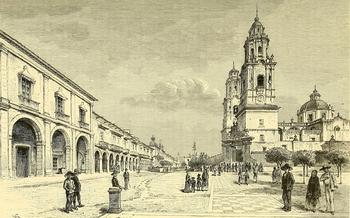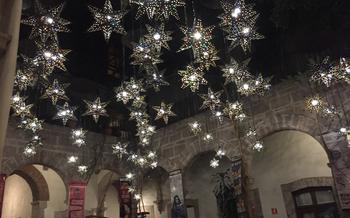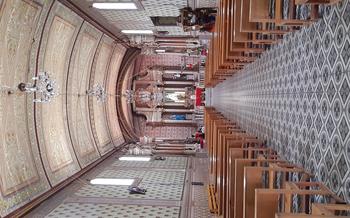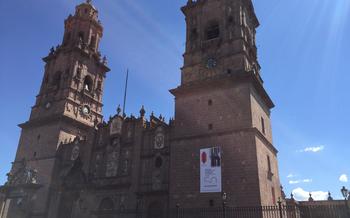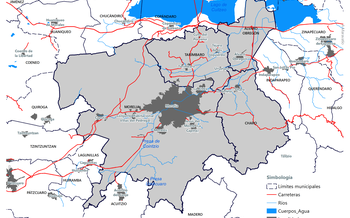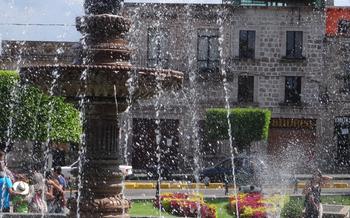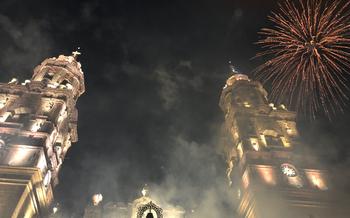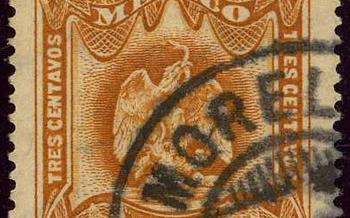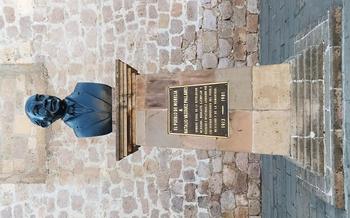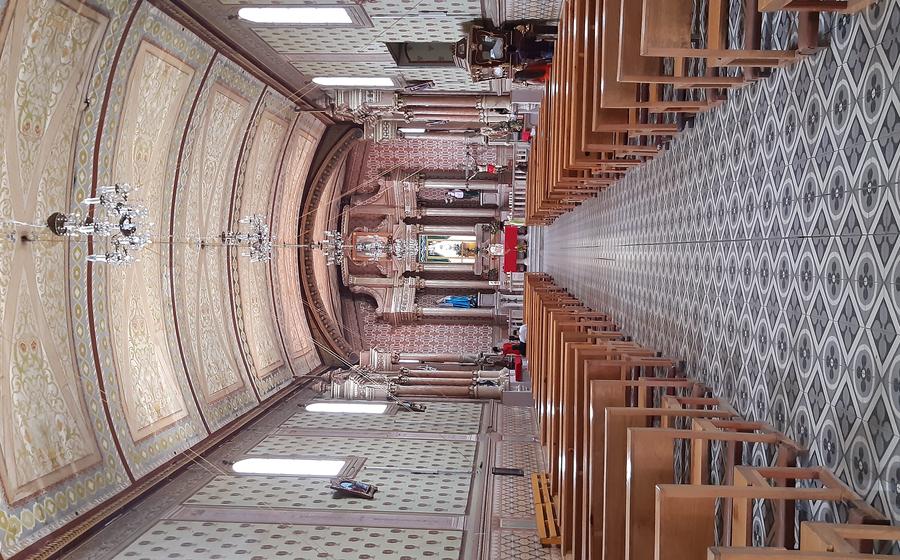
Museo de la Estampa en Pátzcuaro
- Museo de la Estampa en Pátzcuaro: A Showcase of Mexican Prints
- Exploring the Museum's Unique Collection
- The Art of Engraving in Mexico
- Understanding the Printmaking Process
- Tools and Materials
- Interactive Demonstrations
- Hands-on Workshops
- The Cultural Context of Mexican Prints
- Workshops and Educational Programs
- Guided Tours and Activities for Visitors
- The Museum Shop and Local Artisans
- Transportation and Accessibility
- Planning Your Visit: Tips and Considerations
- Engaging with the Local Community
- Additional Attractions in the Region
- Insider Tip: Uncovering Hidden Gems
Museo de la Estampa en Pátzcuaro: A Showcase of Mexican Prints
Location and accessibility
Nestled in the heart of P to the rich tradition of engraving in Mexico. The museum is conveniently situated on Calle Dr. Nicolas León, a charming cobblestone street lined with colonial-era buildings. Visitors can easily reach the museum on foot from the town's main square, Plaza Vasco de Quiroga, or by taking a short taxi ride.
Hours of operation and admission fees
The Museo de la Estampa en Pátzcuaro is open to the public from Tuesday to Sunday, with extended hours on weekends. Admission fees are minimal, making the museum an affordable attraction for visitors of all budgets. Guided tours are available upon request, offering a deeper insight into the museum's collection and the art of engraving.
Exploring the Museum's Unique Collection
The Museo de la Estampa en Pátzcuaro houses a remarkable collection of prints that showcase a diverse range of themes and subjects. From traditional Mexican landscapes and historical scenes to contemporary social and political commentary, the prints offer a glimpse into the artistic and cultural heritage of Mexico. Visitors can explore the museum's collection through guided tours or self-guided exploration, learning about the techniques and styles employed by the artists, as well as the historical and cultural context of the prints.
Notable artists featured in the museum's collection include José Guadalupe Posada, Leopoldo Méndez, and Francisco Toledo. Posada's satirical prints, known as calaveras, are particularly celebrated for their biting social commentary and their depiction of Mexican folklore and traditions. Méndez, on the other hand, is renowned for his abstract and geometric prints that explore the relationship between art and mathematics. Toledo's works, often inspired by indigenous Mexican culture and mythology, are known for their vibrant colors and intricate symbolism.
In addition to the permanent collection, the museum also hosts special exhibitions and temporary displays that showcase the works of contemporary printmakers from Mexico and around the world. These exhibitions provide visitors with an opportunity to explore new trends and perspectives in the field of printmaking, as well as to discover the works of emerging and established artists.
The Art of Engraving in Mexico
Engraving has a rich and storied history in Mexico, dating back to the colonial period when it was introduced by European missionaries. Over the centuries, engraving evolved into a significant art form, reflecting the country's unique cultural identity and artistic traditions.
In Pátzcuaro, engraving flourished under the patronage of the Catholic Church and wealthy patrons. Local artisans embraced the technique, using it to create religious imagery, portraits, landscapes, and scenes from everyday life. The city became a renowned center for engraving, attracting artists from across the region.
The distinctive style of Pátzcuaro engraving is characterized by its intricate lines, detailed compositions, and use of shading to create depth and texture. Local engravers often incorporated traditional Mexican motifs and symbols into their work, resulting in a unique blend of European and indigenous influences.
In the 20th century, engraving in Mexico underwent a revival, with artists experimenting with new techniques and styles. Contemporary Mexican engravers continue to draw inspiration from the rich traditions of the past while pushing the boundaries of the art form. Their works are exhibited in galleries and museums worldwide, showcasing the vitality and diversity of Mexican engraving.
Understanding the Printmaking Process
The Museo de la Estampa en Pátzcuaro offers a unique opportunity to delve into the fascinating world of printmaking. Visitors can learn about the basic techniques of engraving, etching, lithography, and screen printing through interactive demonstrations and workshops. Experienced printmakers guide visitors through the stages involved in creating a print, from preparing the plate or matrix to inking, printing, and finishing.
Tools and Materials
The museum showcases a variety of tools and materials used by printmakers, including engraving tools, etching needles, lithographic stones, and screen printing frames. Visitors can gain insights into the different techniques and their unique requirements.
Interactive Demonstrations
Interactive demonstrations provide visitors with a firsthand look at the printmaking process. Skilled artisans demonstrate how to create an image on a plate or matrix, transfer it to paper, and produce a finished print. These demonstrations offer a deeper understanding of the technical aspects of printmaking and the artistry involved.
Hands-on Workshops
For those who want to experience printmaking firsthand, the museum offers hands-on workshops. Participants can learn the basics of a particular technique, create their own prints, and take home their creations as souvenirs. These workshops are suitable for both beginners and experienced artists.
The Cultural Context of Mexican Prints
Mexican prints are not merely works of art; they are deeply embedded in the country's history, identity, and cultural fabric. They often reflect the unique experiences, traditions, and social realities of Mexico. For instance, prints from the early 20th century often depicted scenes of the Mexican Revolution, capturing the struggles and triumphs of the people's fight for independence.
Prints have also been used to express political and social commentary, addressing issues such as poverty, inequality, and social injustice. Renowned Mexican printmaker José Guadalupe Posada created powerful satirical prints that criticized the political and social conditions of his time. His iconic calavera (skull) prints, such as "La Catrina," have become symbols of Mexican art and culture.
Beyond their political and social significance, prints have also played a vital role in popular culture and everyday life in Mexico. They have been used to illustrate books, magazines, and newspapers, and have adorned homes and businesses throughout the country. The colorful and vibrant prints often depict traditional Mexican motifs, such as flowers, animals, and religious figures, reflecting the country's rich cultural heritage.
Workshops and Educational Programs
The Museo de la Estampa en Pátzcuaro offers a variety of workshops, courses, and demonstrations that provide visitors with an opportunity to learn about and engage with the art of printmaking. These educational programs are designed for people of all ages and skill levels, from beginners to experienced artists.
Workshops typically focus on specific printmaking techniques, such as engraving, etching, lithography, and screen printing. Participants learn about the history and process of each technique, as well as how to use the necessary tools and materials. They then have the chance to create their own prints under the guidance of experienced instructors.
The museum also offers courses and seminars that delve deeper into the history, theory, and practice of printmaking. These courses are taught by renowned Mexican and international artists and scholars, and cover topics such as the history of Mexican printmaking, contemporary trends in the field, and the role of prints in Mexican culture.
In addition to workshops and courses, the museum offers demonstrations and guided tours that provide visitors with an overview of the printmaking process and the museum's collection. These activities are a great way to learn more about the art of printmaking and to see the museum's collection up close.
Guided Tours and Activities for Visitors
Immerse Yourself in the World of Prints with Guided Tours
To enhance your visit and delve deeper into the world of printmaking, the Museo de la Estampa en Pátzcuaro offers a variety of guided tours. These tours are led by knowledgeable and passionate guides who bring the museum's collection to life.
Tailored Tours for Diverse Audiences
Whether you're an art enthusiast, a history buff, or simply curious about the process of printmaking, there's a tour designed to suit your interests. General tours provide a broad overview of the museum's highlights, while specialized tours delve into specific themes, techniques, or artists.
Exploring the Museum's Treasures in Different Languages
To cater to visitors from around the world, guided tours are offered in multiple languages, including English, Spanish, and French. This ensures that everyone has the opportunity to fully appreciate the museum's collection and its significance in Mexican art and culture.
Enriching Experiences for Families and Groups
Families with children can embark on interactive tours that engage young minds with fun activities and storytelling. School groups and organized tours can benefit from customized programs that align with their educational curriculum.
Interactive Exhibits and Multimedia Presentations
Throughout the museum, visitors can engage with interactive exhibits and multimedia presentations that bring the art of printmaking to life. These interactive elements enhance the visitor experience by providing a deeper understanding of the techniques and processes involved in creating prints.
The Museum Shop and Local Artisans
The Museo de la Estampa en Pátzcuaro houses a well-curated shop that offers a diverse selection of prints, postcards, and books related to engraving and Mexican art. Visitors can browse and purchase a wide range of artworks, including original prints by local and national artists. By doing so, they directly support the local art community and contribute to the preservation of this traditional art form.
The museum shop also features a collection of handcrafted items created by local artisans, showcasing the region's rich cultural heritage. Visitors can find unique souvenirs, such as pottery, textiles, and jewelry, that reflect the skills and creativity of the local community. Purchasing these items not only supports the local economy but also helps to promote cultural exchange and appreciation.
The museum's commitment to ethical and sustainable practices extends to the museum shop. Visitors can be assured that the products sold are sourced from responsible suppliers and artisans who uphold fair labor standards. By shopping at the museum shop, visitors contribute to the sustainability and growth of the local art scene while taking home a piece of Mexican culture to cherish.
Transportation and Accessibility
Getting to Pátzcuaro: - Public Transportation: Regular buses and colectivos (shared vans) depart from major cities like Morelia, Guadalajara, and Mexico City to Pátzcuaro. - Driving: Pátzcuaro is accessible by car via well-maintained highways. Rental cars are available at major airports and cities. - Air Travel: The closest airport to Pátzcuaro is the Morelia International Airport (MLM), approximately 50 kilometers away. Direct flights are available from various cities in Mexico and the United States.
Navigating Pátzcuaro: - Walking: The historic center of Pátzcuaro is compact and easily explored on foot. Many attractions, including the Museo de la Estampa, are within walking distance. - Local Transportation: Local buses and taxis are readily available to transport visitors to different parts of the town.
Accessibility for Visitors with Disabilities: - The Museo de la Estampa is wheelchair accessible, with ramps and elevators providing access to all floors. - Designated parking spaces for visitors with disabilities are available near the museum. - Guided tours can be arranged in advance to accommodate visitors with specific needs.
Parking Facilities: - Street parking is limited in the historic center, but several public parking lots are available within walking distance of the museum. - Fees for parking vary depending on the location and duration.
Planning Your Visit: Tips and Considerations
Best Time to Visit:
Aim for the dry season (November to May) for pleasant weather and clear skies. The museum is open year-round, but some special events and exhibitions may have specific dates or times. Check the museum's website or contact them directly for the most up-to-date information.
Suggested Duration:
Plan to spend at least 1-2 hours exploring the museum's collection and exhibits. If you're particularly interested in printmaking or want to participate in a workshop or guided tour, allow for more time.
Dress Code and Etiquette:
Casual attire is appropriate for visiting the museum. Remember to be respectful of the artwork and other visitors by maintaining a quiet and orderly environment.
Photography and Social Media:
Photography is generally allowed inside the museum, but using a flash or tripod may be restricted. Please follow the museum's guidelines and be mindful of other visitors when taking photos. Sharing your experiences on social media is encouraged, but remember to tag the museum and use relevant hashtags.
Engaging with the Local Community
Visiting the Museo de la Estampa en Pátzcuaro is not just about admiring the artwork but also about connecting with the local community and delving deeper into the cultural fabric of Pátzcuaro. Here are some ways to engage with the locals and enrich your overall experience:
-
Attend cultural events and festivals: Pátzcuaro hosts a vibrant calendar of cultural events throughout the year, including art exhibitions, music concerts, traditional dance performances, and indigenous festivals. These events provide an excellent opportunity to immerse yourself in the local culture and interact with the friendly residents.
-
Volunteer or participate in community projects: For those who wish to give back and contribute to the community, there are various volunteer opportunities available in Pátzcuaro. You can work with local organizations involved in art education, environmental conservation, or community development projects.
-
Interact with local artists and printmakers: Pátzcuaro is home to a thriving community of artists and printmakers who are passionate about their craft. Visitors are encouraged to visit local galleries, studios, and workshops to meet the artists, learn about their techniques, and purchase their unique artworks.
-
Respectful and responsible interactions: When engaging with the local community, it is essential to be respectful of their customs and traditions. Learn a few Spanish phrases to communicate with the locals and always ask permission before taking photos of people or places. Remember to be mindful of your actions and ensure that your interactions are mutually beneficial and positive.
Additional Attractions in the Region
Beyond Pátzcuaro, the surroundinguntzan, an ancient Purépecha capital, boasts impressive archaeological ruins and a picturesque lakeside setting. Santa Clara del Cobre is renowned for its copper handicrafts, with workshops where visitors can witness the traditional techniques firsthand. Janitzio Island**, a captivating island on Lake Pátzcuaro, is known for its Day of the Dead celebrations and its towering statue of José María Morelos, a hero of the Mexican Independence War.
For nature enthusiasts, the region offers stunning landscapes and outdoor activities. El Cerro del Estribo, a nearby mountain, provides breathtaking views of the lake and surrounding countryside. Visitors can embark on scenic hikes, mountain biking trails, or horseback riding excursions. Lake Pátzcuaro itself offers opportunities for boat tours, kayaking, and fishing, allowing visitors to immerse themselves in the region's natural beauty.
Morelia, the capital of Michoacán state, is also within easy reach of Pátzcuaro. This vibrant city is home to well-preserved colonial architecture, grand plazas, and numerous museums, including the Museo del Estado de Michoacán, which houses a significant collection of pre-Hispanic artifacts and colonial art.
Planning a comprehensive itinerary that incorporates visits to multiple destinations in the region is highly recommended. This allows travelers to experience the diverse cultural, historical, and natural attractions that the area has to offer. Whether seeking ancient ruins, traditional crafts, stunning landscapes, or colonial cities, the region surrounding Pátzcuaro offers something for every traveler.
Insider Tip: Uncovering Hidden Gems
Beyond the Museo de la Estampa en Pátzcuaro, there are hidden gems waiting to be discovered by curious travelers. For those seeking a deeper immersion into the world of printmaking, a visit to local galleries, studios, and workshops is a must. These intimate spaces offer a glimpse into the creative processes of local artists and provide an opportunity to purchase unique and authentic artworks.
One such hidden gem is the Taller de Gráfica Popular, a renowned printmaking workshop founded in Mexico City in 193With a focus on social and political themes, the Taller has produced iconic prints that have played a significant role in Mexican history. Visitors can tour the workshop, learn about its history, and see firsthand the techniques used by its talented printmakers.
For those interested in contemporary printmaking, the Galería de Arte Contemporáneo de Pátzcuaro is a must-visit. This gallery showcases the works of emerging and established Mexican artists, including many who specialize in printmaking. Here, visitors can admire a diverse range of styles and techniques, from traditional to experimental, and perhaps even discover a new favorite artist.
Whether you're a seasoned art collector or simply curious about the world of printmaking, uncovering these hidden gems will enhance your visit to Pátzcuaro and provide a deeper understanding of the rich artistic traditions of Mexico.
